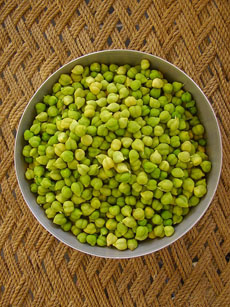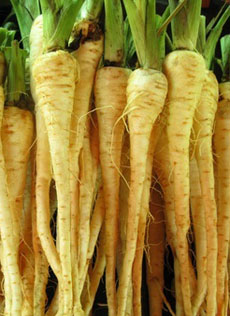|
Love garbanzo beans (a.k.a. ceci and chickpeas)? Most of us have only seen these legumes canned or dried.
But you can buy fresh garbanzo beans* from specialty produce purveyors year-round. It’s an altogether different eating experience.
Each nutty green bean is enveloped in a thin, papery skin. To enjoy fresh garbanzos, simply sauté, steam or boil the beans with the skin on.
Then squeeze each bean out of its wrapper, just as with edamame.
As with canned and dried beans, fresh garbanzos can be mashed into dip, tossed into a salad and made into falafel and hummus.
But first eat the fresh garbanzos plain, like edamame, as a snack or in a green salad. You’ll be charmed by the flavor.
Get some fresh garbanzo beans for yourself, send some to your favorite garbanzo bean lover. The clam shell pack can be stored for 7-10 days in the produce crisper.
|
|

The real (fresh) deal: fresh garbanzo
beans (chickpeas) (photo © Melissas).
|
Californians may be able to find the Garden Green Garbanzos brand in local markets, fresh-frozen. Or, order by phone from our favorite specialty produce purveyor, Melissas.com: 800-588-0151 (currently, there is no online ordering because of price fluctuations).
GARBANZO BEAN NUTRITION
Garbanzos are high in calories, but they are all good calories. The beans are an excellent source of protein and cholesterol-lowering fiber. Their high level of insoluble fiber helps to prevent digestive disorders such as diverticulosis and IBS. Garbanzo bean group participants had better blood fat regulation—including lower levels of LDL-cholesterol, total cholesterol, and triglycerides—than the group that consumed dietary fiber from another source.
Garbanzos are an excellent source of folate (vitamin B9) and contain the antioxidant vitamins A & C along along with other good-for-you phytonutrients. Low in fat, saturated fat, cholesterol, and sodium, garbanzos are a heart-healthy food.
Whole Foods Market reports a recent study where participants reported more satisfaction with their diet when garbanzo beans were included. They consumed fewer processed food snacks and less food overall.
____________________
*There are two main varieties of garbanzos. Desi are small, angular and variegated in color and were probably the original chickpea cultivated. Today, the predominant variety is the kabuli, a large beaked pea.
|
|

Fresh chickpeas (photo ©Khalid Mahmood | Wikipedia). |
|
HOW THE CHICKPEA GOT ITS NAME
Call it Bengal gram, ceci bean, chana, garbanzo bean or sanagalu: The chickpea is one of the earliest cultivated legumes. Remains have been found in the Middle East that date back 7,500 years.
“Chickpea” evolved from the Latin cicer, which happens to be the same root as the Roman name Cicero. The Oxford English Dictionary lists a 1548 citation that reads, “Cicer may be named in English Cich, or ciche pease, after the Frenche tonge.” By the mid-18th century, ciche peas became chick-peas.
The word “garbanzo” is a bit more obscure. It is first noted in English in the 17th century, as “calavance,” perhaps from the Old Spanish algarroba. There is also a possible Basque word parent, garbantzu, a compound of garau, seed and antzu, dry.
In ancient Greece, chickpeas (called erébinthos) were consumed raw when young and eaten as a staple food, as well as a dessert. (Today, halua, chickpeas in a sugar base that has some resemblance to peanut brittle, is a popular sweet dish in Bangladesh.)
|
The Romans roasted garbanzos as a snack and cooked them into a broth. Many centuries later, in 18th-century Europe, roasted chickpeas were ground and brewed as a coffee substitute.
We recommend the more conventional uses.
Check out the different types of beans and legumes in our Bean Glossary.
|
|






